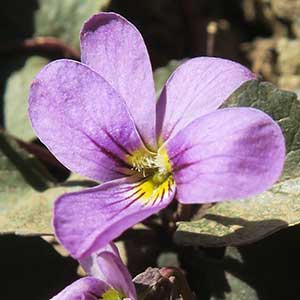Viola flettii
Viola brittoniana
Flett's violet, Olympic violet, rock violet
coast violet, coastal violet, northern coastal violet
1–3, ascending to erect, mostly glabrous, on caudex from fleshy rhizome.
basal and cauline;
basal: 1–3;
stipules linear-lanceolate, margins entire or with glandular processes, apex acuminate;
petiole 1.5–9.7 cm, mostly glabrous;
blade purple-tinted and –veined, broadly reniform to ovate, 0.9–2.4 × 1.2–4 cm, base cordate, margins finely crenate-serrate, eciliate, apex acute to obtuse, surfaces glabrous or sparsely pubescent along veins adaxially;
cauline similar to basal except: stipules ovate to lanceolate, margins entire or shallowly laciniate;
petiole 0.7–5.9 cm, usually glabrous;
blade 0.8–2.1 × 1.2–3.1 cm.
basal, 5–9, ascending to erect, 5–9-lobed;
stipules linear-lanceolate, margins entire, apex obtuse;
petiole 3–16 cm, usually glabrous;
mid-season blades incised or lobed throughout, earliest blades lobed (plants homophyllous), similar to mid-season blades, middle and lateral blade lobes differ in width and/or shape, middle lobes lanceolate or spatulate to narrowly obovate, lateral lobes lanceolate or spatulate to falcate (each sometimes with deltate to falcate appendages or teeth along margins), 1–7 × 2–8 cm, base truncate to cordate, margins entire, ciliate, apex acute to obtuse, surfaces usually glabrous, rarely with a few strigose, hairs concentrated on veins.
1.8–7.1 cm, usually glabrous.
5–18 cm, usually glabrous.
sepals lanceolate, margins eciliate, auricles 0.5–1.5 mm;
petals soft reddish violet on both surfaces, all with yellow area basally, lower 3 dark violet-veined, lateral 2 bearded, lowest with white around yellow area, 10–15 mm, spur yellow, gibbous, 0.5–2 mm;
style head bearded; cleistogamous flowers axillary.
sepals lanceolate to ovate, margins ciliate or eciliate, auricles 2–3 mm;
petals light to soft reddish violet on both surfaces, lower 3 white basally, dark violet-veined, lateral 2 bearded, lowest 10–25 mm, sometimes bearded, spur same color as petals, gibbous, 2–3 mm;
style head beardless; cleistogamous flowers on ascending to erect peduncles.
± spherical, 5–9 mm, glabrous.
ellipsoid, 10–15 mm, glabrous.
dark brown to brownish purple, 2.5–3 mm.
beige, mottled to bronze, 1.5–2.5 mm.
= 54.
Viola flettii
Viola brittoniana
Viola flettii is endemic to the Olympic Mountains of northwestern Washington. C. S. McCreary (2005) noted that although morphologically and ecologically distinct, V. cuneata, V. flettii, and V. ocellata are closely related.
(Discussion copyrighted by Flora of North America; reprinted with permission.)
Britton considered Viola brittoniana similar to V. pedatifida, apparently making him the first to recognize their affinity. Both are homophyllous and similar in other characters (L. E. McKinney 1992). McKinney recognized V. brittoniana as a variety of V. pedatifida. Additional evidence (N. L. Gil-Ad 1997; A. Haines 2011) suggests that these taxa are sufficiently distinct to continue recognition as separate species.
Viola pectinata has sharply dentate leaves and is closely related to V. brittoniana, usually occurring with it. N. L. Gil-Ad (1997) made a convincing argument to recognize it as a form; A. Haines (2011) recognized it as a species. Others have considered it to be a sporadic form that may be of hybrid origin, or, as N. H. Russell (1965) suggested, is due to genetic dimorphism. We are reserving a decision on treating this taxon until additional studies are completed.
A. Haines (2011) reported that the distribution of Viola brittoniana in Maine is actually based on the hybrid V. ×insolita House (V. brittoniana × V. sororia).
Viola brittoniana reportedly hybridizes with V. cucullata (= V. ×notabilis E. P. Bicknell), V. sagittata var. sagittata (= V. ×mulfordiae Pollard), and V. sororia (= V. ×insolita).
(Discussion copyrighted by Flora of North America; reprinted with permission.)


